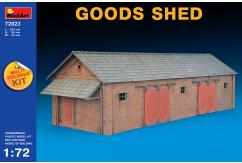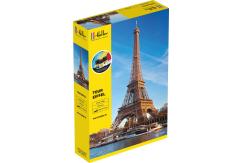Italeri 1/72 La Haye Sainte Waterloo 1815
Manufacturer: Italeri Product Code: 1-6197
1/72 La Haye Sainte Waterloo 1815
Specifications
Scale: 1/72
During the revolutionary wars (1792-1799) and - especially - in the Napoleonic period (1799-1815), France probably had the most efficient war machine on the Old Continent, which almost led to its lasting hegemony over Europe. It will be a truism to say that the key element of this machine was the French army. In the same army, of course, line infantry played a very important role. Shortly after the outbreak of the Revolution, the units formed during the Ancien Regime period were separated from the volunteer units, but already in 1793 an amalgam decree was issued, which created half-brigades of line infantry consisting of the "old" line infantry battalion and two volunteer battalions. However, in 1803 Napoleon restored the regimental system. The French Line Infantry Regiment from 1803 consisted of 3 battalions, and each battalion was divided into 9 infantry companies. Another reorganization took place in 1808, when the two regiments were combined into brigades. On the other hand, the number of battalions in the regiment increased to four, one of which was in-house and did not move into the field. In addition, line battalions already had 6, not 9 companies. From 1808, the French line infantry regiment had as many as 3,970 people. In 1812, just before the campaign in Russia, the French line infantry numbered 130 regiments. The basic armament of the French infantryman was a model 1777 or AN IX rifle with a length of 1.52 meters and a caliber of 15.5 to 17.5 mm. There was also a bayonet. It is worth adding, however, that the French infantry also used captured weapons on a large scale - including Russian or British rifles.
During the revolutionary wars (1792-1799) and - especially - in the Napoleonic period (1799-1815), France probably had the most efficient war machine on the Old Continent, which almost led to its lasting hegemony over Europe. It will be a truism to say that the key element of this machine was the French army. In this army, on the other hand, the Guard played a very important role, along with its artillery. The latter - the Guards artillery - was undoubtedly the elite of the French artillery, especially when it comes to training and combat experience of gunners. In 1809, this artillery consisted of a horse artillery regiment and a foot artillery regiment. Both regiments consisted of mainly 4-, 8- and 12-pounder guns. In 1813, the Gwardia artillery already consisted of a horse artillery regiment belonging to the Old Guard, two foot artillery regiments, one of which belonged to the Old Guard, one to the Young Guard, and two artillery train regiments. The Guard's artillery was used in combat in several great battles and campaigns, including the Battle of Wagram (1809), the Battle of Dresden and Leipzig (1813) and the Battle of Waterloo (1815).
The Battle of Waterloo was fought on June 18, 1815 and was the last battle commanded by Napoleon Bonaparte with the French forces. It is assumed that on the French side, about 65,000 soldiers and 250 guns took part in the battle, while on the Anglo-Dutch and Prussian sides, a total of about 123,000 men, with about 160 guns (excluding Prussian artillery) fought. The French side was led, of course, by the emperor of the French, the allies - Arthur Wellesley, Fr. Wellington, and the Prussians - Gebhard von Blücher. British-Dutch troops, awaiting the arrival of the Prussians, but also based on the experiences of Fr. Wellington, learned from the fighting in Spain, adopted a defensive stance, and their position was supported by farm buildings. The battlefield with boggy ground, soaked with water after intense rainfall, also favored the defenders, as it made it difficult to develop a cavalry attack. The battle began around 11.30 with the French artillery cannonade, and later - with the attacks of the French infantry on the British-Dutch positions. Initially, the fight for the Hougomont farm was fought, but later also on the right flank and in the center of the Allied formation. The next phase of the battle was the British cavalry charges, which were intended to relieve the fighting infantry, which initially brought great success to the British, but were finally repulsed with considerable losses. Despite fierce fighting and attacks led by Marshal Ney, around 4.30 pm, the British positions seemed to be intact, and the Prussians, commanded by Gebhard von Blücher, were already approaching the battlefield. Finally, around 19.30, the 1st Prussian Corps entered the fight - it meant that the scales of victory were tilted towards the allies, despite the Old Guard's attack on British positions. The immediate aftermath of the Battle of Waterloo was Napoleon's abdication and the end of the Napoleonic era in the history of Europe.











